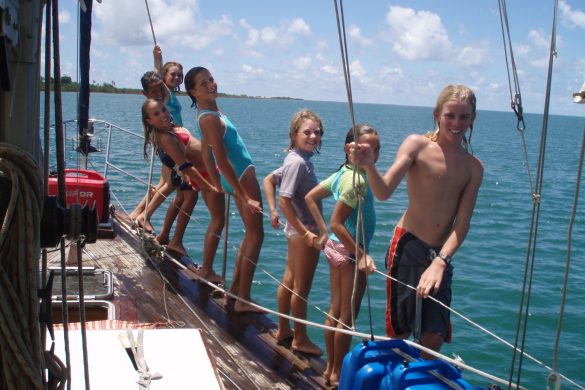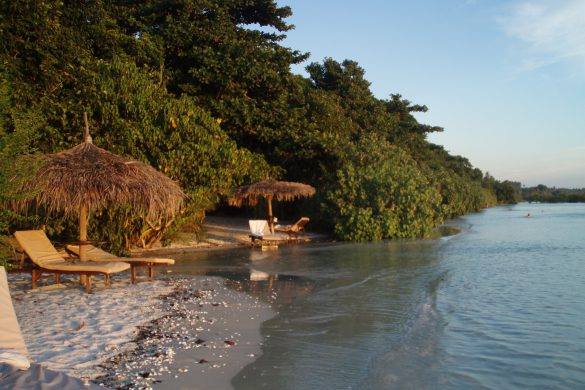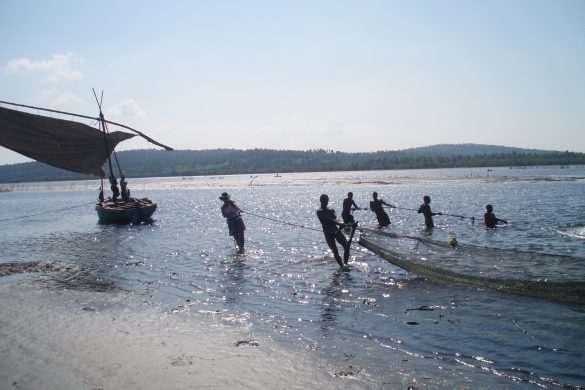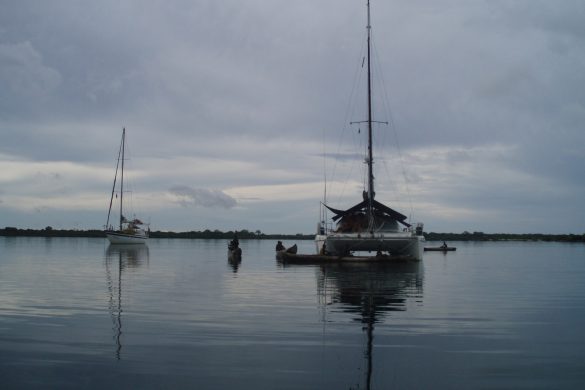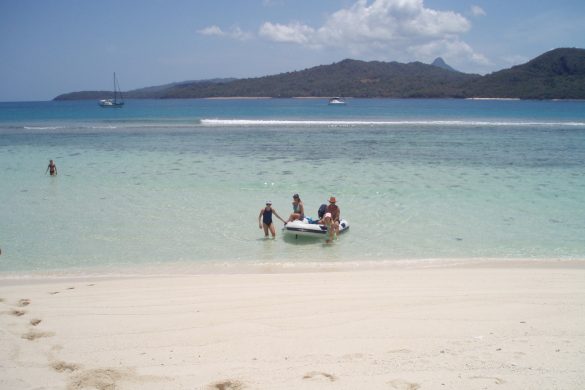I think many yachtsmen dream of the cruising lifestyle or at least of buying a boat to fulfil that dream. We didn’t have the boat, but our family was super-keen to sail into the sunset.
This is how we got hooked… with Bella Luna
By William Edwards
A decision and a Big Red Boat
Being in Cape Town while my Dad had heart surgery made me think about how fragile and short our existence on this planet is. It was the catalyst for the start of our journey towards realising that sailing dream. I went down to the Royal Cape Yacht Club marina, started asking about boats for sale, and eventually came across a big red ketch that had been converted into a sloop.
The owner had cut away the mizzen, insisting that it kept sweeping his guests off the aft deck and into the ocean! The ketch had a lot of good qualities but looks were certainly not one of them.
I returned home to Knysna to make a final decision and I called my great friend, Hylton Hale, who happened to be on the dock looking at Big Red at that time. When I told him I was going to buy the big red boat in front of him, he only just managed to stop himself from falling into the marina. It took some time for him to regain his composure and give me his opinion. With that, we bought the boat.
My friend Colin Whitehead offered to join us as most of the crew had never sailed before. We set off straight into a 35-knot
southeaster with the sea pouring into the cabin. Luckily the Perkins 120-horsepower engine pushed us straight into the teeth of the gale and the big seas. Once we were around Cape Agulhas things calmed down. We turned the engine off and sailed for most of the day in a light to moderate southerly. As the sun set the wind dropped, and I went down to start the motor only to discover that we had a dead short. Colin and I spent most of the night swapping and reconnecting batteries, and hitting the engine with a selection of tools.
Eventually we gave up and spent the night bobbing around in the mist rather close to shore which required us to deploy the anchor. We had just reached the point of finalising who would be eaten first when I decided to have a last go at the engine. I gave the starter motor a smart crack and she started to the sound of loud cheers.
We arrived at the entrance to the Knysna Heads the following morning and it was a great feeling to be bringing Big Red into the Lagoon. My wife Lucinda was waiting on the dock and shouted, ‘My ship has come home.’ We trucked Big Red to our farm. It took two days to remove the ugly bits and five years to transform her into the handsome Bella Luna she is today. Many thanks to Neville Smith, who is an incredible shipwright.
Launch day came and we took the kids out of school for the occasion. Roger Clancy arrived with the low-bed truck and crane. He was very efficient and professional and we soon had Bella Luna travelling down the N2 with a traffic police escort accompanied by a representative from Telkom with a long device to lift the cables across the road to allow the procession to pass underneath. It was an incredible moment when Bella Luna splashed into the lagoon and we celebrated by giving her a formal launching party.
The next month and a half we crammed in skippers’ and radio licence courses, first aid courses and boat surveys to ensure Bella Luna was seaworthy and met SA Maritime Safety Authority safety requirements before we left through the imposing Knysna Heads and headed east for Durban. There we did last-minute adjustments and repairs and loaded Bella Luna with a year’s supply of victuals. I’ll never forget the overwhelming feeling of responsibility to keep my family safe as we passed through Durban harbour and set sail for Bazaruto. Dougie was 12 and Pips was 9 years old.
The Bazaruto Archipelago
The Bazaruto Archipelago features all the positives of tropical-island cruising and you can have a great time snorkelling,
fishing, diving and exploring its islands and bays. You need to pay attention to the tidal range as strong currents can leave you high and dry at times. The yellow canoe that we were towing while island hopping managed to set itself free and headed straight for a beach on Magaruque Island. By the time we had anchored and launched the tender, Luna Tick, the canoe had been taken hostage and a ransom
set at $500 by a local fishing family. We eventually settled at $10, after the family’s head negotiator made us promise that we would not tell anyone that we had struck such a good deal as it would ruin their
business.
It was soon time to head across the channel to Madagascar and we were lucky to be able to stop at Juan de Nova, which is a
French garrison island. The soldiers garrisoned there at the time were super-friendly, invited us to lunch and gave us a tour around their incredible island, pirate hideouts and all. The only condition was that we had to be gone by first light the following morning as their commanding officer was due that day.
We had an uneasy crossing from Juan de Nova to Cap Saint-André in Madagascar as there are reefs that run at least 30 miles off the coast.You can choose to sail inside or outside the reefs. We chose inside. It is quite hair-raising as there are big coral heads in some areas and you need to keep a good lookout.
Madagascar
Madagascar is one of the best cruising experiences you can hope to have. There are plenty of islands and inlets to discover, and among its people we discovered interesting cultures and customs, including ‘fady’, which refers to a wide range of taboos. The Malagasy have such a strong belief in these cultural prohibitions that people, not adhering to them, have been known to simply fade away and die without apparent cause. There is much to do in Madagascar and we spent three months exploring these captivating islands with family and friends.
We completed a short hop to Mayotte and enjoyed some incredible diving with some of the best coral in the eastern Indian
Ocean. Mayotte is a great place to resupply and do the odd repair, but it is very expensive. There is a pleasant yacht club where you can chat to other cruisers and expats who live on the island.
Seychelles
The crossing from Mayotte to Seychelles should be an easy fetch turning into a beam reach, but an occasional tropical depression can form and the weather can become quite unsettled. Localised rain squalls can catch you very much unaware. The Seychelles offers superb cruising with many great anchorages and beaches, and superb snorkelling. You can stock up well with provisions but it is rather pricey. We had a great time here and enjoyed visits from friends and family. We spent Christmas on Curieuse Island among giant tortoises and crabs that peered at us rather disapprovingly as our party got into full swing.
Lamu Island, Kenya
The crossing from Seychelles to Lamu Island, which is on the northern Kenyan coastline, is relatively easy. Once you’re away from the Seychelles bank, you can settle in to the northeasterly trades and a beam reach for eight days without touching the sails. Lamu is fascinating. It is the oldest Swahili town dating back more than a thousand years. Transportation is by donkey and camel. You may encounter an eclectic mix of individuals – from international celebrities to descendants of survivors from Chinese Emperor Zheng, whose fleet was shipwrecked there in 1415. There are superb coffee bars and little restaurants and plenty to see and do.
East African Coast
We left Lamu with heavy hearts and started our slow journey home along the East African coast. By then we were truly into the cruising lifestyle and I was confident that I could keep my family safe. I took stock of how we had all adapted to this new way of life. We were all leaner, fitter and healthier and the kids were freediving down to 10 metres. Dougie and Pips became our food suppliers with their fishing and bartering skills and there was not a day that we felt short of nourishment.
The East African coastal journey can be done as a day sail from Lamu, travelling south past some incredible inlets, island chains and villages, dating back to the slave and ivory trade. Our children were experiencing history first hand. A little bit of school work was completed every day, including tests and experiments, and we managed to cover big chunks of the syllabus during the crossings.
The officialdom encountered along the African coast can be tiring, but there are a few things to know that really help:
• Never be in a hurry.
• Always appear very friendly and a bit simple.
• Take the family with you when you’re clearing in or out or performing any other official duty. Have the children tearfully hand over pieces of cake and half litres of Coca-Cola to the official.
• Always keep well-worn, small denomination notes of various currencies, preferably slightly damp, in a jewellery box and let this appear to be your worldly wealth.
The official soon loses patience and normally clears your documents thinking that you are a bunch of idiots not worth
wasting any more time on as there could be better opportunities for a bribe. Overall, we found most people friendly and helpful and never felt unsafe at all.
We thoroughly enjoyed the sail from Lamu to Durban. It took us about four months as we stopped almost every night or stayed longer either in the lee of a pristine island, in a beautiful bay or up a river. The natural beauty and colour of the water is difficult to describe and so was the overwhelming feeling of achievement and sense of privilege we felt to have done this together.
SCHOOLING AT SEA ON BELLA LUNA
-By Lucinda Edwards
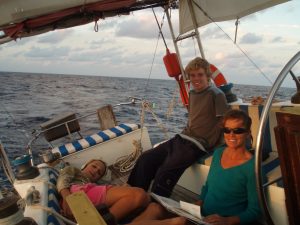
Schooling at sea
Because we left in May and returned in June (with SA schools running from January to December), we followed the Grade 3 and 4 syllabus for Pippa and Grade 6 and 7 for Dougie using the Oxford University Press school books.
The beauty of this system is that for science in Grade 3, for example, they draw the water cycle with a very simple picture,
with big writing. In Grade 6, the reference is exactly the same basic picture, but with smaller writing, and more information
and pictures. Both children could learn from each other’s books.
One day we opened Douglas’ history book to find the next chapter was about the Kilwa ruins, and we had just arrived in
Kilwa! His cousin was studying the same chapter so we sent her ‘real’ pictures for her school project in Cape Town.
As regards routine, I tried to be strict but it was not that easy. We tried to do at least two hours a day of school but if it was low tide or we had just arrived at a new destination, school would be shifted so that we could go snorkelling or
exploring instead. In total there were about six learning subjects and we set a written test per subject every day. I set about 20 questions per test and the kids had to study.
We also did dictation for English, so they would listen and spell the words. They wrote many essays, read aloud, and were
usually tested on comprehension. We did lots of projects and experiments such as filtration with building materials. And of course we studied the fish, turtles, birds and corals.
We took a couple of days off per week to simulate weekends and when friends or family came to visit that would be our school holiday period. We did it somehow, because when we returned to ‘normal life’ Doug went straight in to complete Grade 7 and on to Grey High School. At the Grey interview they loved the fact that he had so much to talk about and he loved sharing all his experiences.
Pips slotted straight back into Plettenberg Bay Primary School and also blossomed. From then on orals and school essays were easy because they had so much to say.
[ Bella Luna Sailing Sabbatical ]


